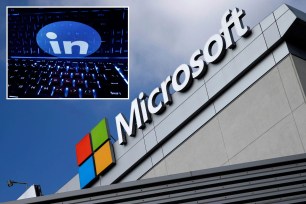Business
CNN plans to lay off hundreds of employees
The job cuts come as CNN looks to rearrange its linear TV lineup and building out digital subscription products.
More in Business
California mom and 'queenpin' in beauty product crime ring ordered to pay millions
January 22, 2025 | 4:00pmMichelle Mack, 54, the married, mother-of-three “queenpin,” was ordered to pay $3 million in restitution to Ulta, Sephora and a number of other retailers her crime ring targeted, according to...
ByteDance director confident TikTok deal will get done, sees options to avoid an outright sale
January 22, 2025 | 12:59pmBill Ford, the CEO of ByteDance shareholder General Atlantic, said Wednesday he was confident that a deal will be reached to ensure TikTok stays online in the US — and...
Anti-DEI activists target major banks like Goldman Sachs, JPMorgan: report
January 22, 2025 | 12:54pmActivists have taken aim at Wall Street banks over their diversity, equity and inclusion policies.
JPMorgan Chase CEO Jamie Dimon says he 'hugged it out' with Elon Musk after earlier clashes
January 22, 2025 | 12:20pmJPMorgan had sued Tesla in 2021, kicking off a drawn-out dispute that was at least in part tied to Musk's infamous 2018 tweet where he said he had "funding secured" to...
LinkedIn sued for disclosing customer information to train AI models
January 22, 2025 | 12:04pmPremium customers said LinkedIn disclosed their private messages to third parties without permission to train generative artificial intelligence models.
Samsung Galaxy S25 series photos and features leak online — stoking anticipation for unveiling
January 22, 2025 | 11:47amNew Samsung phones said to be chock full of innovative features -- chief among them the integration of the Galaxy AI artificial intelligence platform.
Netflix shares soar to all-time high as investors cheer subscriber growth, price hikes
January 22, 2025 | 11:25amThe company’s global subscriber base now exceeds 300 million, giving it a commanding lead in the streaming wars.
Elon Musk, Sam Altman trade barbs as Tesla mogul shades OpenAI over $500B Stargate project
January 22, 2025 | 10:38amElon Musk threw shade at OpenAI’s Sam Altman on Tuesday after his rival took center stage at the White House to unveil his ambitious $500 billion “Stargate” AI infrastructure project.
Jamie Dimon says US stock market ‘kind of inflated,’ critics need to ‘get over’ Trump tariffs
January 22, 2025 | 10:17amAt the World Economic Forum in Davos, Switzerland on Wednesday, JPMorgan Chase CEO Jamie Dimon cautioned investors on the risks of increased deficit spending, sticky inflation and geopolitical tensions.
CNN boss' warning to Jake Tapper, Anderson Cooper and 100 other journalists over Trump inauguration
January 22, 2025 | 9:50amCNN boss Mark Thompson urged CNN staffers to focus on Trump's second term and to be "open-minded" about the next four years, according to a report.
Trump welcomes idea of Elon Musk buying TikTok — if billionaire wants it
January 21, 2025 | 7:04pm“I met with the owners of Tiktok, the big owners, it’s worthless if it doesn’t get a permit,” Trump said. “It’s worth like a trillion dollars."
JetBlue now accepting popular app as payment method for flights
January 21, 2025 | 4:40pmThe option will become available on their app 'in the coming months,'
Trump's meme coin starts to recover after SEC unveils 'crypto task force'
January 21, 2025 | 4:35pmThe token started to bounce back after SEC acting Chair Mark Uyeda unveiled a new team tasked with “developing a comprehensive and clear regulatory framework for crypto assets.”
Netflix hiking prices after adding record 19M quarterly subscribers
January 21, 2025 | 4:35pm"We enter 2025 with strong momentum," Netflix said in its note to investors, saying it added a record 41 million subscribers in 2024 and re-accelerated growth.
TikTok still in limbo, unavailable on US app stores as uncertainty around Trump's 75-day extension swirls
January 21, 2025 | 4:27pmTikTok remained unavailable in Google and Apple app stores on Tuesday as President Trump’s executive order delaying enforcement on Congress’s sale-or-ban bill by 75 days fueled uncertainty about the app’s...
Megyn Kelly rips Lauren Sánchez over her racy outfit at Trump inauguration: 'No one should be talking about your t-ts'
January 21, 2025 | 3:23pmThe host of the SiriusXM podcast "The Megyn Kelly Show" eviscerated Sánchez, fiancée of Amazon founder Jeff Bezos.
Meteorologists give tearful goodbyes as local TV stations replace them with Weather Channel feed
January 21, 2025 | 3:20pmAllen Media Group will lay off or reassign at least 50 workers across all of its local stations, according to a report.
Goldman taps next generation of leaders in Wall Street revamp
January 21, 2025 | 2:41pmGoldman Sachs CEO David Solomon promoted a slew of top bankers on Tuesday to run the firm's biggest business units, just days after the bank boss was awarded a pair...
Longtime Washington Post editor flees embattled Jeff Bezos paper to join CNN
January 21, 2025 | 1:46pmRucker's departure is a high-profile loss for the Washington Post, which has faced a wave of resignations due to dissatisfaction with its leadership.
Adidas seals turnaround year with strong quarterly sales — after Kanye disaster
January 21, 2025 | 1:34pmFor the full year, revenue was up 12%, hitting nearly $25 billion.

























